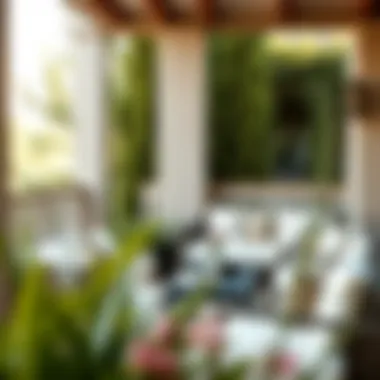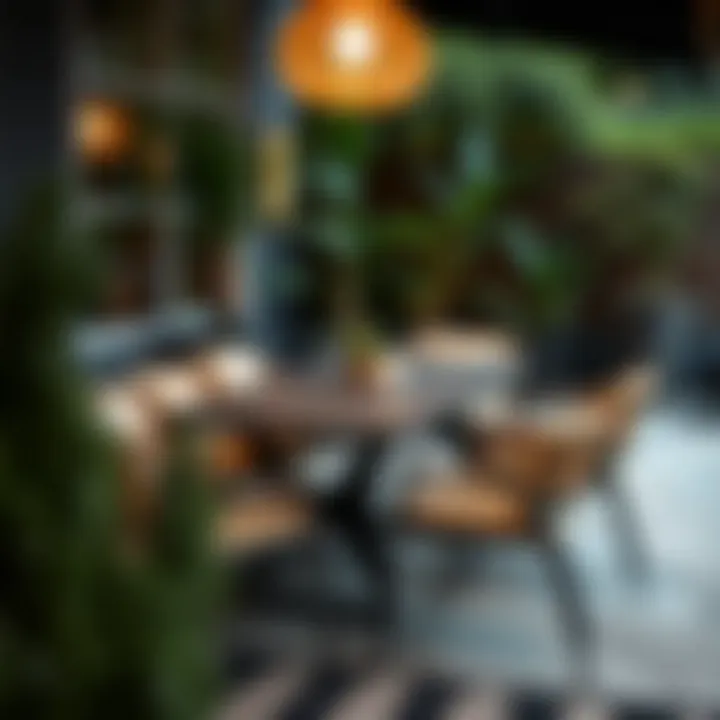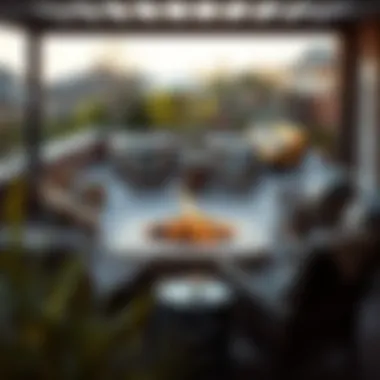A Comprehensive Guide to Outdoor Furnishings


Intro
Outdoor furnishings have come a long way, shifting from simple and utilitarian designs to sophisticated, stylish pieces that elevate the outdoor experience. As homeowners invest in their outdoor spaces, understanding the nuances of their options becomes crucial. With the right knowledge, anyone can enhance their patio, deck, or garden into a functional and alluring environment.
This article delves into the realm of outdoor furnishings. We will explore the current design trends, material choices, and maintenance practices that can significantly alter the landscape of your outdoor area. Homeowners, designers, retailers, and DIY enthusiasts will find valuable insights here, allowing them to make informed decisions when choosing outdoor furniture. The following sections aim not just to inform but rather to inspire you to curate a space that reflects your personal style while catering to your comfort and practicality needs.
So, whether you’re looking to embrace the latest trends or seeking to understand how to meld functionality with aesthetics, you’re in the right place. Let’s take a closer look at design trends that are shaping the outdoor furniture landscape today.
Understanding Outdoor Furnishings
Outdoor furnishings are not just about chairs and tables thrown into the yard. They represent a significant aspect of contemporary living, bridging the gap between our indoor spaces and the great outdoors. As backyards transform into extensions of our homes, the importance of understanding outdoor furnishings becomes increasingly clear. Knowing the purpose, materials, design styles, and functionalities can greatly enhance the outdoor experience, making it not only stylish but also efficient and practical.
Definition and Purpose
Outdoor furnishings can be defined as furniture designed specifically for outdoor environments. These pieces are crafted to withstand weather elements while providing comfort and style. Think of a cozy lounge chair that beckons you to relax after a long day, or a sturdy dining set that invites family and friends for al fresco meals. At their core, outdoor furnishings serve a dual purpose: they allow for the enjoyment of outdoor spaces and add aesthetic value to your property.
One of the main benefits of investing in quality outdoor furniture is its role in enhancing social interaction. When spaces are furnished thoughtfully, they encourage gatherings and conversations, fostering connections among loved ones. Moreover, well-designed outdoor areas can increase the value of your home, making them a worthwhile investment.
The Evolution of Outdoor Furniture
The journey of outdoor furniture is quite fascinating. Historically, pieces dated back to ancient Greece and Rome were often simple, functional items. However, as the centuries rolled on, the approach to outdoor living began to shift. During the Renaissance, ornately designed pieces came into vogue, reflecting the wealth and ostentation of the era's elite.
Fast forward to the 20th century, and the post-war boom saw a surge in suburban living, which included the rise of the backyard as a social gathering spot. People began seeking out comfortable outdoor seating and functional dining solutions. Brands like Herman Miller introduced iconic designs like the Eames Lounge Chair crafted for both indoor and outdoor settings.
Fast forward to today, we understand outdoor furnishings not just as functional items, but as elements that contribute to our holistic lifestyle. The focus has shifted towards sustainability and innovation, with manufacturers often using recycled materials and ergonomic designs. Smart outdoor furniture that integrates technology is also gaining traction, allowing for a more connected lifestyle.
Overall, understanding outdoor furnishings is pivotal, as it shapes how we interact with our surroundings, making our outdoor spaces not only usable but also enjoyable.
"A well-furnished outdoor space is an invitation to relax, connect and enjoy the beauty of nature right at home."
By diving into the specifics of materials, styles, and maintenance later in this piece, readers can further enrich their knowledge and make informed decisions that elevate their outdoor environments.
Materials Used in Outdoor Furnishings
The materials chosen for outdoor furnishings play a crucial role in defining not just the aesthetics, but also the longevity and functionality of outdoor spaces. When one thinks about patio furniture or garden decor, the types of materials can often dictate the feel of the space. With the right choices, outdoor areas can transform into inviting havens, where relaxation is just a breath away. It’s essential to weigh different materials based on durability, maintenance needs, and personal style.
Wood: A Traditional Choice
Wood has stood the test of time, becoming a beloved material for outdoor furniture. Its natural beauty adds charm to any setting, providing a warm and inviting atmosphere.
Teak
Teak is renowned in the world of outdoor furnishings for its remarkable resilience. The oil content found in teak helps combat moisture and prevents the wood from warping or cracking. It's often considered the gold standard when it comes to outdoor furniture because of its ability to withstand harsh weather conditions. One unique feature of teak is its ability to develop a silvery-grey patina over time if left untreated, adding character. Advantages: Low maintenance and highly durable, making it a worthwhile investment. Disadvantages: Higher price point might not fit every budget.
Cedar
Cedar is another wood commonly used in outdoor settings. Known for its distinctive scent, it has natural insect-repelling properties that make it an appealing option. The soft woods of cedar also makes it easy to work with during crafting. Unlike other woods, cedar can withstand decay, given it is properly sealed. Advantages: Lightweight and readily available, suits a variety of designs. Disadvantages: Less durable than teak, requiring periodic maintenance.
Redwood
While not as widely known, redwood provides an elegant solution for outdoor furnishings. Its rich hues add a touch of sophistication to any patio. Redwood is similar to teak in that it also contains natural oils which help in resisting insects and decay. Its unique grain patterns can stand out beautifully in any setting. Advantages: Remarkable resistance to warping makes it a reliable option. Disadvantages: More difficult to source sustainably, thus affecting environmental impact.
Metal: Modern Durability
Metal has emerged as a trendy choice for outdoor furnishings, known for its sleek lines and modern appeal. It brings a structured look to any space, enabling the creation of contemporary designs.
Aluminum
Aluminum stands out for its lightweight nature paired with incredible durability. It does not rust and is highly resistant to corrosion, making it suitable for diverse climates. An exciting characteristic of aluminum furniture is its ability to be easily molded into various shapes and styles, providing designers with numerous options. Advantages: Resistant to rust and easy to maintain. Disadvantages: Can get hot under direct sun, making it uncomfortable to sit on during heatwaves.
Steel
Steel furniture offers a contemporary aesthetic, lending a robust feel to outdoor spaces. Known for its strength, steel provides a firm foundation for furniture. However, it is heavier than aluminum, which might be a consideration for some. With the right coatings, steel can resist corrosion effectively. Advantages: Long-lasting and offers a sleek, modern aesthetic. Disadvantages: If not properly treated, steel can corrode over time.
Iron
Wrought iron chairs and tables have a majestic appeal that often evokes a sense of timeless elegance. Known for its strength, iron can be designed with intricate detailing. However, just like steel, it is susceptible to rust, which suggests that outdoor furniture made from iron should be adequately finished or treated to prevent wear. Advantages: Unmatched durability and character. Disadvantages: Heavy and may be prone to rust without care.
Synthetic Materials
As outdoor furniture evolves, synthetic materials provide an innovative and modern flair. These materials often combine functionality with style, making them increasingly popular.
Resin Wicker
Resin wicker has gained traction as a trendy and long-lasting alternative to traditional wicker. Made from synthetic fibers, it offers the same aesthetic without the risk of deterioration outdoors. This material is indeed designed to handle various weather conditions, ensuring it maintains its shape and color over time. Advantages: Extremely low maintenance and available in numerous styles. Disadvantages: May lack the warmth of natural materials.
Plastic Composites
Plastic composites are engineered for high-performance, combining plastics and wood fibers to create durable surface materials. These composites resist fading and cracking, offering another layer of sustainability to outdoor furnishings. Advantages: Lightweight, versatile, and environmentally friendly. Disadvantages: Some might not find the look as appealing as natural wood or metal.
Textilene
Textilene is a durable fabric often used for outdoor furniture cushions and seats. It’s a staple in the industry due to its UV-resistant properties and easy clean-up. Often used in lounge chairs and cushions, it combines comfort with practicality. Advantages: Quick-drying and remains vibrant in color despite sun exposure. Disadvantages: Texture might not suit those accustomed to natural fabrics.
Choosing the right material is pivotal in shaping the atmosphere and functionality of outdoor spaces. The selection delves into personal style, maintenance preferences, and environmental considerations.
Design Styles for Outdoor Spaces


When it comes to outdoor furnishings, the design style plays a pivotal role in shaping the ambiance and functionality of the space. Homeowners, designers, and enthusiasts alike seek not just pieces that offer comfort but also those that resonate with their personal taste and the environment in which they exist. Each design style brings its own unique flair, marrying aesthetics with practical considerations. By understanding these variations, one can transform an ordinary backyard into an inviting retreat or a chic entertaining area.
The right design style can enhance the character of the space, guiding choices in color, material, and arrangement. It is essential to consider the existing architecture, landscape, and the intended use of the area. An effective outdoor space reflects harmony, allowing homeowners to blend nature seamlessly with functionality. Here’s a closer look at some popular styles that define the world of outdoor furnishings.
Contemporary Designs
In contemporary styles, simplicity reigns supreme, often showcasing clean lines and minimalistic aesthetics. It's an approach that focuses on using materials like aluminum and glass, which not only suit a modern lifestyle but also require less maintenance. Furniture pieces can often be multi-functional, catering to both relaxation and entertainment needs.
- Key Features: Straight edges, neutral color palettes, and innovative designs often highlight contemporary outdoor spaces.
- Benefits: They fit well into urban settings and can easily adapt to various small spaces, providing elegance without overwhelming them.
- Considerations: While the focus is on aesthetics, ensuring durability against elements still remains critical for the longevity of the furnishings.
Rustic Charm
Rustic design has a way of bringing warmth and a sense of timelessness to outdoor areas. Think reclaimed wood, natural stone, and earthy tones that evoke a sense of connection to nature. Rustic charm is all about creating a cozy atmosphere reminiscent of countrysides or secluded retreats.
- Key Features: Worn finishes, barn-style furniture, and organic fabrics contribute to the overall inviting nature of rustic outdoor setups.
- Benefits: This style gives off a relaxed vibe, making it ideal for family gatherings or casual get-togethers with friends.
- Considerations: Maintenance may involve regular checks for wear and tear, given the natural materials used. Also, it’s essential to balance rustic elements to avoid a cluttered appearance.
Classic Elegance
Classic elegance draws inspiration from traditional designs which often feature ornate details and refined finishes. Outdoor furnishings in this style might include wrought iron chairs or teak wood tables, presenting a sophisticated yet inviting atmosphere.
- Key Features: Curved designs, intricate patterns, and luxurious fabrics elevate the aesthetic appeal.
- Benefits: The classic approach remains versatile, suiting formal events or peaceful mornings with a cup of coffee.
- Considerations: While elegance takes center stage, combining comfort is crucial to ensure that usability remains high on the list for outdoor entertaining.
Bohemian Vibes
If you prefer a more free-spirited approach, then the Bohemian vibe might just be your cup of tea. This design style celebrates creativity and individuality, often incorporating an eclectic mix of colors, patterns, and textures. Think of vibrant cushions, layered rugs, and dangling lights creating an inviting atmosphere.
- Key Features: A varied color palette and an assortment of accessories that encourage relaxation and creativity.
- Benefits: It invites spontaneity and personalization, letting one’s creativity shine through without rigid rules.
- Considerations: Balance is key. Overcrowding with too many mixed patterns can detract from the refreshing spirit of the Bohemian style.
In exploring these design styles, one can better navigate the choices in outdoor furnishings. Each style carries its own essence, paving the way to both form and function in outdoor living spaces.
Functional Considerations
When designing outdoor spaces, the practical functionality of furnishings plays a pivotal role. Beyond aesthetics, functional outdoor furnishings must address several key aspects that contribute to a seamless, enjoyable outdoor experience. It’s all well and good to have a pretty patio, but if the furniture isn’t up to snuff under various weather conditions, lacks ergonomic support, or is poorly positioned, it won’t be the inviting sanctuary one hopes for. Addressing these functional considerations ensures your outdoor area serves not just as decorative flair but as a fully operational extension of your home.
Weather Resistance
Outdoor furniture needs to weather the storms—literally. Weather resistance is paramount since outdoor pieces are exposed to the elements. Rain, sun, snow, and humidity can take a toll on many materials. For example, a beautiful wooden table might warp or splinter after a few seasons without proper care. Hence, it’s essential to choose materials designed to withstand such conditions.
- Teak and Eucalyptus are excellent choices due to their natural oils that resist moisture and insects.
- Metal options, like powder-coated aluminum, combat rust effectively.
- For synthetic materials, high-density polyethylene (HDPE) and resin wicker offer durability against fading and cracking.
By prioritizing weather-resistant options, homeowners can ensure their outdoor furnishings don’t just survive but thrive through the changing seasons.
"The right furniture can turn a rainy day into a cozy retreat."
Ergonomics and Comfort
Next up is ergonomics and comfort, which should never be an afterthought. Picture this: You’re hosting a lovely garden party, and guests are fidgeting in their chairs after just a short while. Uncomfortable seating can turn a relaxing evening into a fleeting visit. Choosing ergonomically designed pieces ensures that comfort is woven into the fabric of your outdoor environment.
- Look for furniture that supports posture and minimizes strain, such as chairs with a slight recline or tables at suitable heights for dining.
- Cushions also play a crucial role; opt for sun-resistant materials that retain comfort while being easy on the eyes.
Beyond just aesthetics, comfort enhances the experience of spending time outdoors.
Space Planning
Lastly, let's talk about space planning. It's often the behind-the-scenes hero in outdoor design. An intelligently arranged space can maximize usability and flow, making even the smallest yards feel open and inviting. Think about it: crowding everything together might seem like a good idea at first, but it can lead to an overwhelming and cramped space.
Consider the following when planning:
- Zoning: Divide areas for different activities, like dining, lounging, and gardening.
- Flow: Ensure there's enough room to move around comfortably; pathways should be clear of obstruction.
- Furniture Scale: Choose pieces that fit the space. Oversized sectionals can dwarf a small patio while causing congestion.
Keeping functional considerations at the forefront of design will ultimately enhance both the aesthetic and usability of outdoor living areas. This thoughtful approach turns any outdoor setting from simply a space into an experience.
Color and Fabric Choices
When it comes to outdoor furnishings, the interplay of color and fabric plays a pivotal role in crafting an inviting atmosphere. The right selection can transform a drab space into a haven of relaxation, while also influencing the mood and perception of the environment. Homeowners, designers, and enthusiasts alike should consider not just aesthetics, but also practicality when mixing colors and choosing materials.
The importance of color choices is about more than just personal preference. Bright, lively colors can bring energy to a space, while muted tones may create a sense of tranquility. Furthermore, these hues can also complement the overall landscape, enhancing rather than competing with natural elements.
Fabric selections also bear significant weight, as different materials interact with sunlight, moisture, and wear. Thus, multiple key points emerge: aesthetics, durability, and maintenance. Tackling these can be the difference between a beautiful outdoor area and one that falls flat.
Color Psychology in Outdoor Spaces
Color psychology is an area of study that delves into how colors affect feelings and behaviors. In outdoor settings, the impact can be profound. For instance, blue tones often invoke calmness and serenity, making them suitable for spaces meant to relax, like a patio or poolside. On the flip side, warm tones like red and orange can foster excitement and social interaction.
When designing an outdoor area, it’s beneficial to consider the emotional response each color might elicit. Did you know that green, reminiscent of nature, can create a sense of balance and harmony? Incorporating this color into your furniture may foster a connection to the outdoors, enhancing the ambience.
Undoubtedly, using a palette harmonized with the environment can augment comfort. Whether creating bold contrasts or blending seamlessly with surroundings, an awareness of color psychology is key to achieving a desired atmosphere.
Choosing the Right Fabrics
Selecting the correct fabrics for outdoor furnishings is nothing short of vital. The interplay of function, durability, and style can dictate how well the furnishings perform while also contributing to their visual appeal.
Sun-Resistant Materials
One significant consideration when choosing fabrics is their resistance to sun damage. Sun-resistant materials help to mitigate fading, ensuring that vibrant colors remain intact even under relentless sunlight. A standout option within this category is solution-dyed acrylic fabric, known for retaining its color much longer than other fabrics.
These materials are not only long-lasting but also pleasant to the touch, adding comfort to the outdoor experience. Their durability makes them an increasingly popular choice among homeowners, and they can withstand the elements without losing texture or color.
However, it’s important to note that while these fabrics might be a bit pricier upfront, the long-term investment in quality typically pays off in reduced replacement costs. Furthermore, their easy-clean nature helps simplify maintenance, further enhancing their appeal.


Stain-Resistant Options
Another layer to consider in fabric choices is stain resistance. Stain-resistant options, such as polyester blends treated with protective coatings, are designed to repel spills and dirt. This characteristic makes them especially desirable for outdoor settings where food and drink may pose a risk to fabric integrity.
These fabrics maintain their appearance over time, escaping the common fate of unsightly stains that can ruin even the most carefully curated décor. The unique feature of stain-resistant fabrics is that they offer a peace of mind, allowing users to enjoy their outdoor activities without constant worry over cleanup.
"An outdoor space without thoughtful choices in color and fabric is like a blank canvas waiting for paint. It has potential, but lacks vibrance."
By understanding the significance behind your selections, you can resonate with guests and create outdoor settings that feel truly curated.
Maintenance and Care
Maintaining outdoor furnishings is not merely a chore; it’s an investment in the longevity and aesthetic appeal of one's outdoor spaces. Proper upkeep can ensure that furniture remains functional and visually pleasing throughout the seasons. Outdoor furniture often confronts harsh weather conditions, pests, and wear from daily use. By adopting systematic maintenance practices, homeowners can save money in the long run, prolonging the life of their purchases and enhancing the overall enjoyment of their outdoor areas.
Cleaning Techniques for Different Materials
Effectively cleaning outdoor furniture varies significantly depending on the material used. Here's a closer look at how to maintain popular materials:
- Wood: A gentle wash with soap and water followed by thorough drying is the way to go. Avoid heavy-duty cleaners that can strip finishes or sealants. Using a soft-bristle brush can help dislodge dirt in crevices.
- Metal: Metals like aluminum or stainless steel require occasional cleaning with a solution of vinegar and water. This prevents oxidation and keeps surfaces shiny. Pay special attention to corners to prevent rust formation.
- Synthetic Materials: Materials such as resin wicker withstand cleaning with mild soap and a soft cloth. While resistant to weather, a regular cleaning schedule – typically every few weeks during heavy use – prevents buildup of mildew or dirt.
Protecting Your Investment
Protecting outdoor furnishings transcends simple cleaning; it involves strategic choices and practices that stabilize their condition over time.
Seasonal Storage
Seasonal storage is a critical component of protecting outdoor furniture. During winter months or off-seasons, it’s prudent to store furniture in a dry, sheltered place, such as a garage or shed. This helps in shielding items from snow, rain, and ice that can corrode or warp materials.
- Key Characteristic: One of the standout aspects of seasonal storage is indeed its ability to extend the lifespan of furniture by preventing physical damage and discoloration. Furthermore, seasonal storage also minimizes the risk of infestations from pests that can thrive in damp environments.
- Advantages: By employing seasonal storage, your investment leaves more room for enjoyment when brought out in sunny months without the worry of needing immediate replacements or repairs.
Protective Covers
Protective covers are another essential tool in outdoor furniture maintenance. These covers are built to shield furniture from adverse weather, bird droppings, and debris when not in use.
- Key Characteristic: They tend to fit snugly over items, providing all-round protection while allowing airflow to prevent mold and mildew growth.
- Advantages: Using protective covers ensures that pieces are ready for immediate use when brought back into service; this minimizes cleaning efforts significantly, as well as reduces long-term wear and tear. However, it’s vital to select breathable fabrics to avoid trapping moisture underneath.
Investing time in the maintenance and care of outdoor furnishings offers long-term benefits that go beyond aesthetic appeal, including safety, comfort, and sustainability.
Safety and Compliance
Safety and compliance in outdoor furnishings can’t be overlooked. From the materials used to their placement, a comprehensive understanding is crucial for ensuring a safe and enjoyable outdoor environment. Particularly for households with children or pets, evaluating safety measures becomes a fundamental task. Choosing products that meet safety standards and considering factors like stability and non-toxicity safeguards both loved ones and the integrity of your outdoor space.
Adhering to safety and compliance helps protect individuals from potential hazards such as sharp edges, flammable materials, and unstable installations. It ensures that the outdoor furniture can withstand use and weather conditions. Involving safety standards in your choices relates not only to personal well-being but also to legal requirements if one sells or installs these products commercially.
Understanding Safety Standards
Safety standards for outdoor furnishings can vary widely depending on the materials and design. Generally, adherence to regulations set by bodies such as the American Society for Testing and Materials (ASTM) or the National Fire Protection Association (NFPA) is invaluable. These organizations provide guidelines ensuring that furniture is safe from fire hazards, sturdy for public use, and manufactured from non-toxic materials.
Here are several key aspects to consider:
- Material Safety: It's critical to select furniture crafted from materials that comply with safety guidelines. For example, painted metals should have low levels of lead, while wood treated with chemicals must be safe for outdoor use.
- Stability and Design: An outdoor chair that topples easily can cause accidents, especially for children. Look for products with wide bases or those engineered to resist high winds.
- Weather Resistance: Furniture should withstand weather extremes without losing integrity, thus preventing potential injuries from weakened structures.
Child and Pet Safety
When it comes to outdoor spaces, child and pet safety stands as a vital consideration, especially if your gatherings include younger members or furry companions. Furniture designed with safety in mind can significantly reduce the risk of injury.
Several elements contribute to safeguarding children and pets in outdoor environments:
- Rounded Edges: Opting for furniture with softened edges helps mitigate the risk of cuts or bruises for children who are prone to running around.
- Durable Materials: Products made from sturdy materials prevent breakage, which is especially important with lively pets. Certain plastics and metals withstand rough treatment better than glass or thin wood.
- Non-Toxic Finishes: Furniture that is treated with safe, non-toxic finishes avoids hazardous substances that could endanger pets or youngsters. It’s essential to inquire about coatings when purchasing.
- Secure Placement: Ensuring furniture is stable and secured anchors the overall setup. Heavy items should not be positioned near play areas to avoid any tipping hazards.
As one might say, "An ounce of prevention is worth a pound of cure." Keeping safety front and center adds significant value to your investment in outdoor amenities.
Trends in Outdoor Furnishings
In the realm of outdoor furnishings, staying on top of trends is essential. These trends not only signify what’s in vogue for aesthetic appeal but also reflect broader shifts towards sustainability and technology. By understanding current trends, homeowners and designers can make informed choices that resonate with their personal style while accommodating environmental considerations. It’s not just about selecting furniture; it’s about creating an outdoor space that mirrors comfort, functionality, and contemporary ideals.
Sustainable Practices
Sustainability has taken the spotlight in recent years, influencing the design and production of outdoor furniture. Consumers are increasingly aware of the environmental impact of their purchasing choices, and many are opting for materials that are eco-friendly. Several brands are turning to recycled materials, sustainable wood sources, and zero-emission production methods. Using bamboo, for instance, is gaining traction due to its fast growth and renewability. Not only does it present a charming aesthetic, but it also offers durability.
Consider these sustainable practices when selecting your outdoor furniture:
- Recycled Materials: Look for pieces made from repurposed plastics or metals.
- Local Sourcing: Choosing local brands reduces carbon footprints associated with shipping.
- Natural Finishes: Eco-friendly paints and varnishes minimize harmful chemicals in production and disposal.
Investment in sustainable outdoor furnishings can translate into cost savings over time through lower maintenance needs and increased longevity. It can also add to the overall value of your property. "Going green" isn’t just a trend; it’s become a philosophy that uplifts outdoor living.
Smart Outdoor Furniture
With the advent of technology, the concept of outdoor furniture has transformed significantly, leading to what is broadly termed as 'smart outdoor furniture'. This encompasses various innovations that enhance convenience and functionality. Imagine lounge chairs with built-in Bluetooth speakers or tables equipped with wireless charging capabilities. These features meld seamlessly with modern lifestyles, allowing for a sophisticated outdoor experience.
Here are some elements that showcase the shift towards smart outdoor designs:
- Integrated Lighting: Furniture pieces with built-in LED lights not only enhance aesthetics but can be practical for evening gatherings.
- Weather Monitoring: Some smart furniture can track weather conditions, providing alerts to protect your investment.
- Modular Designs: Options that enable reconfiguration based on changing needs or gatherings can be particularly appealing for those who entertain often.
Smart outdoor furniture isn't merely a luxury; it’s a trend reflecting convenience and a higher quality of life. These innovative designs encourage outdoor living while blending seamlessly with nature.
Budgeting for Outdoor Furnishings


When it comes to outdoor furnishings, many homeowners find themselves in a tizzy trying to balance style with affordability. Budgeting effectively not only involves assessing how much one is willing to spend but also understanding the key elements that can affect overall costs. Having a clear budget allows consumers to make informed decisions about materials, styles, and features that best fit their outdoor space without breaking the bank.
Understanding Costs
First off, let's break down some factors that play into the pricing of outdoor furniture.
- Materials: Different materials come with varying price tags. For instance, teak and hardwoods tend to command higher prices due to their durability and classic aesthetic. On the other hand, aluminum and synthetic options might be more budget-friendly yet still stylish and functional.
- Design Complexity: Customized designs or unique patterns usually cost more to manufacture. A simple bench might be more economical than an intricately designed dining set with matching chairs.
- Size and Quantity: Larger spaces requiring more pieces will naturally incur higher costs. A well-thought-out plan considering what’s truly needed versus what’s wanted can lead to smarter purchases.
Benefits of Thoughtful Budgeting
Why is budgeting crucial? For starters, having a budget keeps financial expectations realistic. It allows individuals to prioritize essential pieces without succumbing to the allure of extravagant purchases. Additionally, a sensible budget lays down a path for comparing similar items across different retailers, making it easier to find quality without sacrificing personal taste.
Another benefit plain to see is reduced stress; sticking to a budget can help avoid impulse spending that often leads to regret later.
"A penny saved is a penny earned."
This old saying rings true in outdoor furnishing, where mindful spending can lead to beautiful yet sustainable outdoor environments.
Pricing Guide
Establishing a price range for outdoor furnishings can feel daunting, yet it’s essential for staying on track. Let’s take a look at what typical prices might be:
- Seating:
- Tables:
- Accessories:
- Simple plastic or resin chairs: about $30-100 each.
- High-end wooden lounge chairs: can range from $150-500.
- Basic metal tables: around $100-200.
- Ornate patio dining tables: between $300-1,200.
- Cushions can cost anywhere from $10-100 each, depending on quality.
- Outdoor rugs: you might spend $50-300, based on size and style.
Taking these average costs into account can help in formulating a thorough spending plan, allowing for a thoughtfully curated outdoor oasis.
Value vs. Cost
One notable distinction to keep in mind when diving into outdoor furnishings is between value and cost. Cost is merely the price tag, whereas value encompasses the overall quality and longevity of the product. In many instances, spending a bit more upfront can yield superior returns in durability and satisfaction over time.
- Quality Over Quantity: Investing in high-quality materials may seem expensive initially; however, these items often outlast cheaper alternatives, leading to better long-term savings. For instance, a high-grade teak patio set, while pricier at first, may endure decades with the right maintenance, whereas a less expensive plastic set might need to be replaced every few years.
- Function and Aesthetic Value: It’s also wise to consider how well the furnishings will serve their purpose and enhance the aesthetics of your space. Sometimes, it’s better to pay a bit more for a piece that truly captures the essence of your outdoor vision.
By navigating these financial waters with awareness, homeowners can transform their outdoor settings into inviting retreats without stretching their wallets too thin.
Where to Source Outdoor Furnishings
Finding the right outdoor furnishings isn't simply about aesthetics; it's a process that requires consideration of various factors including price, quality, and how well pieces will end up complementing each other in your outdoor space. An effective source for outdoor furniture can influence everything from style to the durability to your eventual satisfaction. With the myriad of options available today, it can promote a sense of personal expression as well as fulfill functional needs.
Local Retailers vs. Online Shopping
When it comes to shopping for outdoor furnishings, the choice between local retailers and online platforms often comes down to personal preferences and situations. Local retailers often provide the advantage of being able to touch and see the products in person. For instance, one might find that a particular fabric feels different when it’s actually in hand compared to how it looks on a screen. Plus, engaging with knowledgeable staff can be beneficial to receive personalized advice, fostering informed choices.
However, shopping locally can sometimes limit options significantly, particularly when it comes to unique style or specific materials. Conversely, the allure of online shopping lies in its vast selection and convenience; platforms like Wayfair or Amazon boast comprehensive catalogs, allowing you to browse from your sofa while sipping on a cup of coffee. Additionally, shopping online often provides room for comparative price checking without the pressure of an in-store salesperson hovering nearby. Nevertheless, it's worth keeping shipping costs and delivery delays in mind when making decisions.
In short, each method glints with its own advantages:
- Local Retailers
- Online Shopping
- Personal interaction with sales staff
- Opportunity to see and feel the products
- Immediate gratification with no waiting for delivery
- Wider variety and choice
- Ease of comparing prices
- Access to customer reviews and ratings
Custom-Made Options
For those who truly want to carve out a unique space, custom-made outdoor furnishings offer a special appeal. Going the tailor-made route may come with a heftier price tag, but it ensures that your selections are perfectly suited to your exact specifications. Options for customization can range from selecting materials that match your vision to crafting a piece that fits the peculiar dimensions of your patio or deck. Consider the beauty of a handcrafted bench made from reclaimed teak, bringing an eco-conscious element right into your garden.
Working with local artisans or designers can also support your community while securing one-of-a-kind pieces that speak to your personal taste. Engaging with professionals can yield not just functional solutions but stunning works of art that accentuate the outdoor space genuinely. The end result often justifies the investment, providing years of fulfillment.
In the realm of outdoor furnishings, whether you opt for store-bought pieces or something more personalized, taking the time to source wisely can elevate the style of your outdoor space tremendously. Ultimately, your choices reflect your lifestyle, and achieving balance between practicality and creativity will shape an outdoor environment that you'll love to unwind in for years ahead.
"The charm of outdoor spaces lies not just in their appearance, but how they echo the personality of those who inhabit them. Make it count."
For more insights on sourcing and outdoor furnishing options, don't hesitate to explore resources like Wikipedia or follow community discussions on Reddit. They can provide varying perspectives that might just inspire your next outdoor project.
Case Studies in Effective Outdoor Design
Understanding how outdoor furnishings are placed and utilized in various settings can serve as a valuable guide for anyone looking to enhance their outdoor areas. Case studies in effective outdoor design highlight practical applications of furniture choices, helping homeowners and designers to visualize and adapt ideas that resonate with their spaces. These examples also reveal the evolution of styles, materials, and layouts, making them instrumental in showcasing not only aesthetic appeal but also functionality.
By analyzing real-life cases, individuals and businesses can draw inspiration and understand potential challenges. When one comprehensively reviews what works and what doesn't in outdoor design, it becomes easier to curate a personal outdoor aesthetic tailored to specific needs and preferences. Here’s a deeper look into two major categories that illustrate these concepts: residential spaces and commercial installations.
Residential Spaces
Residential outdoor spaces offer a canvas for homeowners to express personal style while creating comfortable and inviting environments. One standout case is that of a backyard in a suburban area transformed into a cohesive outdoor living room.
- Design Elements: The homeowners chose a mix of weather-resistant teak furniture and metal accents. The use of lounge chairs, a dining table, and a fire pit created distinct zones for relaxation and entertainment.
- Color and Fabric: Subtle hues of blues and greens were selected for the cushions, resonating with the surrounding landscape, while also incorporating durable, sun-resistant fabrics.
- Landscaping: Combining natural foliage with well-placed planters gave a lush look while maintaining visibility. The integration with native plants helped keep the environment low-maintenance.
The results were remarkable. Friends and family now gather more often, showcasing how thoughtful design enhances social dynamics and encourages outdoor engagement. Such transformations draw attention to the essence of combining beauty with utility, elevating not just property value but personal satisfaction.
Commercial Installations
In the commercial sector, effective outdoor design can significantly boost customer experience and sales. Consider a café situated in a busy urban area that underwent a redesign of its outdoor seating:
- Strategic Layout: They utilized modular furniture that can be easily rearranged. This flexibility accommodated both small groups and bigger crowds, adapting to the café's varying traffic throughout the week.
- Material Choices: The café opted for aluminum tables and chairs for their lightweight yet sturdy nature, complemented by comfortable cushions made from stain-resistant materials to withstand spills from food and drinks.
- Ambiance Creation: String lights and potted plants created a warm atmosphere in the evenings, luring potential customers off the bustling street.
The results varied but notably showed an uptick in both foot traffic and prolonged visitor durations, as patrons felt more inclined to linger in the inviting space. This exemplifies how smart outdoor design informs both customer behavior and business success, effectively connecting aesthetics with profit.
"Outdoor spaces can transform lives, often weaving together community and nature in a practical, beautiful tapestry."
In wrapping up, these case studies illustrate just how crucial thoughtful outdoor furnishings are—not just for comfort’s sake, but also in fostering connections, whether at home or in public venues. By analyzing such real-world applications, you can build your own coherent outdoor narrative that reflects style, sustainability, and sensibility.















